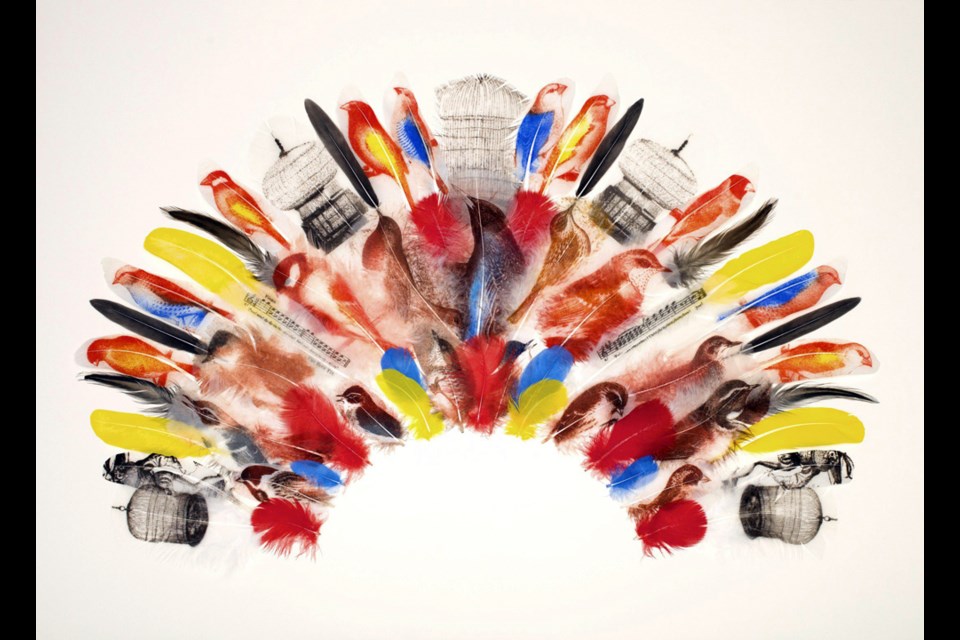Rebecca Jewell has flown here from London, bringing her solo exhibition titled Soaring High, Landing Hard: The Veneration and Exploitation of Birds (Alcheringa Gallery, 621 Fort St., 250-383-8224, until July 6).
In a presentation she made shortly after the opening, Jewell opened my eyes to both halves of her subtitle — the use of feathers as a supreme adornment of chiefs and kings, and the catastrophic destruction of all things that fly by we humans. I came away both inspired … and troubled.
Jewell is a Londoner, through and through. The child of two zoologists, she is the eventual result of those projects of the British Empire: the Victorian-era colonization of the world, and an attempt to make that world better through scientific understanding.
After university training, she worked at London’s Museum of Mankind (which closed 15 years ago), classifying and sorting its vast collections of ethnological objects. She strove to present them not as anonymous artifacts but as works of art. Inspired by a year spent in Papua New Guinea when she was 18, Jewell developed a focus on the arts of the South Pacific, specifically things made from feathers.
The museum closed, by which time she had found the time spent classifying deracinated tribal goods was unsatisfying. So she took up the artistic side of her nature and studied at the Royal College of Art, where, in 2004, she graduated with a PhD. Her special study was in scientific illustration with watercolours. Naturally, for subject matter she applied her prodigious talent to things with feathers. When feather capes and helmets from Hawaii are deemed too fragile to travel, museums sometimes loan Jewell’s paintings instead.
While working as an artist in residence at the British Museum and elsewhere, Jewell was only too aware of the massive collections of dead birds: captured, killed and classified in the name of scientific understanding. She told us of two examples — the Whitney expedition in the 1920s brought home 40,000 birds to the American Natural History Museum. In 1932, the same museum purchased the Walter Rothschild Collection of 300,000 birds. The scientific reason for this collecting mania — which is ongoing — seems harder and harder to justify, in our age of photography and DNA sampling.
Jewell’s sensibility was further heightened by a trip to Malta in 2012 with the Birdlife organization. She was there to bear witness to the anachronistic slaughter of millions of birds. They are systematically taken, both spring and fall, from their flyways that cross this barren Mediterranean island. Ten thousand “traditional” registered hunters, in radio contact, harvest the skies: for sport, for trophies or to serve on plates as rarities for tourists.
While studying printmaking in London, Jewell was introduced to “paper lithography” by which drawings — hers and others — could be photocopied and printed with etching ink onto all manner of materials. She chose feathers. Her mother brought moulted feathers from their ducks and chickens, and Jewell printed images on them. She printed antique drawings by legendary ornithologists, transcriptions of bird song, and the long Latin Linnean classifications by which these innocent creatures are defined and catalogued. The feathers, white in the beginning, are sometimes tinted with etching ink. Jewell remarked that the barbs of feathers took the ink in a way that reminded her of the engraved lines of the old prints she was copying.
In many ways, her printed feathers take part in the veneration aspect of feathers. She has made tiaras of printed feathers, and small replicas of the fabulous royal Hawaiian feathered capes. When assembled in diagonal patterns, her printed feathers make attractive wall decorations, which, from a distance, look like paintings by Jean-Paul Riopelle. The artistic aspect of her work is unmistakable.
She has also applied her imagery, in the form of photo-collage, to photographs of the ships in which Victorian collectors sailed the South Pacific, bringing home cargoes that included the corpses of tens of thousands of birds. Jewell has applied printed feathers to the (fibreglass) shell of an impossibly large egg. One of the most telling of her artworks is a grid of cardboard name tags, each with a hummingbird printed across it. The image of the little bird extends beyond the tag. The tags represent what we know of the birds, but the little soul is seen just passing by.
Jewell’s work is not a polemic, not an impassioned cry to save the natural world in this “now or never” moment. She retains a certain respect for those amateurs and missionaries and explorers who thought that capturing and classifying things was the way to truth. To her, museums seem to be serving an educational purpose with all their dried, pinned and labelled specimens. When I reflect on our own museum’s current public presentation — the subject is a notoriously extinct creature — I wonder what we might yet learn from all those drawers of bird skins. Perhaps, as Joni Mitchell reminded us, “you don’t know what you’ve got till it’s gone.”
The most beautiful of Jewell’s artworks, and the most haunting, is the centrepiece at Alcheringa. A fine nylon “mist net” is stretched a little in front of the wall, its inescapable knots capturing flocks of printed feathers. Each carries a memory — an engraving, a Latin or common name, a trite transcription of some bird’s song. Memories are, in far too many cases, all that remain of more and more bird species. On the wall behind Jewell’s feathers, ghostly shadows hint at what was once a miracle of pulsing, migrating, fantastically beautiful flight.
Hope, as Emily Dickinson said, is the thing with feathers.
